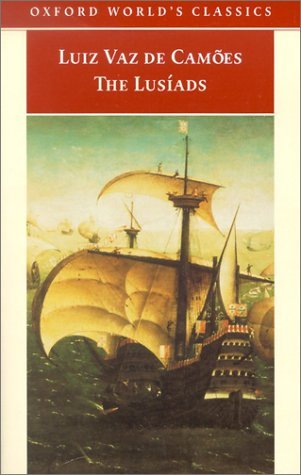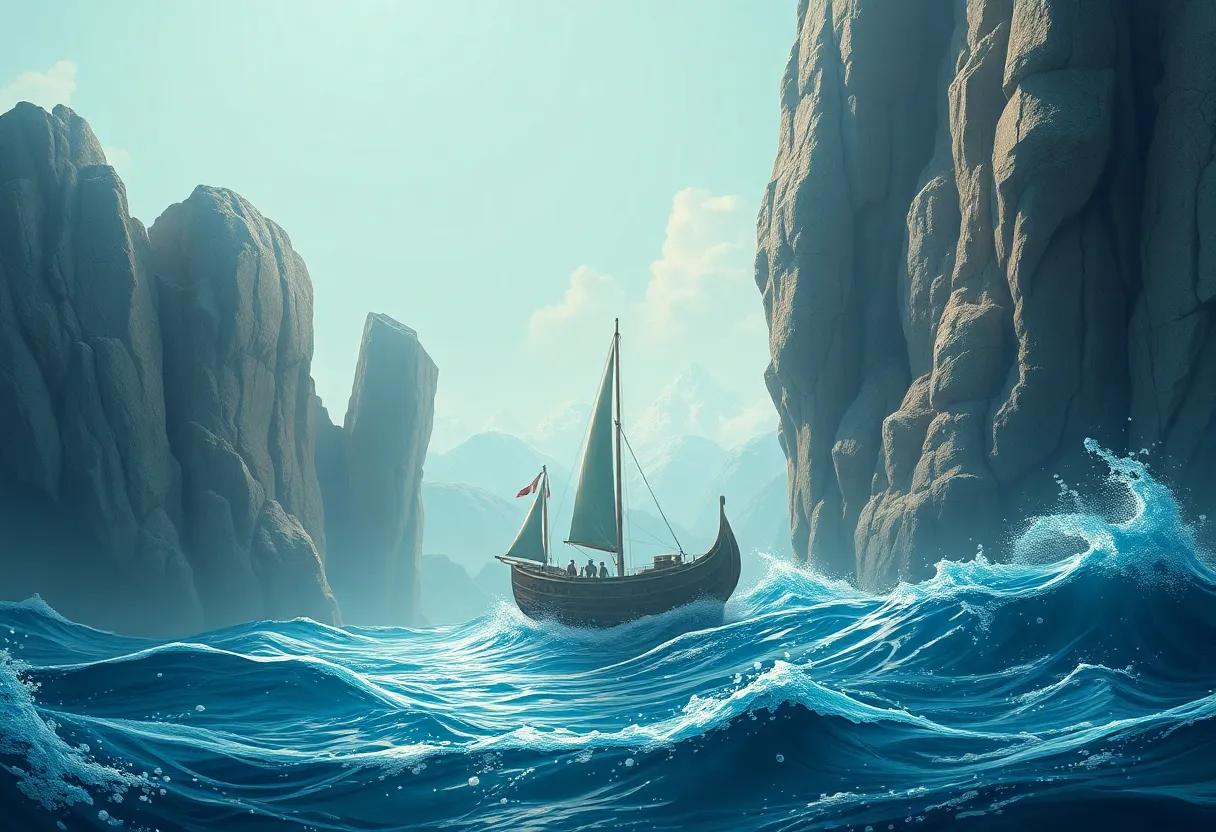In the realm of epic literature, where the grandiose merges seamlessly wiht the intimate, few works stand as testament to the enduring power of words like “The Lusiads” by the Portuguese poet Luís de Camões. Written in the 16th century, this monumental poem navigates the treacherous waters of history and myth, chronicling the voyages of Vasco da Gama and the daring spirit of exploration that defined an era. As readers embark on this literary journey, they are invited to unravel layers of adventure, valor, and cultural dialog—elements that resonate even in today’s world. In this review, we will delve into the intricate tapestry of Camões’ narrative, exploring the thematic depth and stylistic brilliance that have cemented “The Lusiads” as an essential cornerstone of Western literature.Join us as we set sail on this epic exploration of human aspiration and existential reflection, charting a course through the vibrant seas of inventiveness and history.
Exploring the Oceanic Scope of Adventure in The Lusiads
The immersive journey through The Lusiads encapsulates not just the physical adventure of seafaring but also the spiritual and philosophical exploration of finding and conquest. Camões portrays the vastness of the ocean as a metaphor for the expanse of human ambition and aspiration. As Vasco da Gama navigates through perilous waters and encounters mythical beings, the narrative transcends mere storytelling, inviting readers to ponder the essence of heroism and the moral dilemmas faced by explorers. The ocean becomes a character of its own, shaped by the trials and tribulations of those who dare to traverse its depths.
In this epic, the ocean stands as a testament to the duality of nature—its beauty and ferocity. Camões artfully weaves together historical events with intricate descriptions of the sea, emphasizing its unpredictable nature. The verses illustrate the challenges faced by sailors, such as:
- Braving tumultuous storms
- encountering uncharted territories
- Facing mythical creatures
- Contending with the unknown
This interplay of adventure and introspection culminates in a rich tapestry of human experience that reflects our innate desire to explore the world beyond our horizons.
The power of Heroism and Valor in Camões’ Characters
Throughout ‘The Lusiads,’ Luís de Camões crafts a vivid tapestry of heroism and valor,showcasing characters who embody the noble virtues expected of epic heroes. Central to this narrative are figures like Vasco da Gama and his crew, whose journeys reflect the timeless struggle against adversity.Their courage is not merely in their physical conquests but also in their unwavering commitment to their mission, standing tall against not only the elements but also the doubts and fears that haunt them. Camões illustrates this through their willingness to sacrifice for the greater good, making them relatable despite the grandeur of their adventures.
The valor displayed by Camões’ characters frequently enough manifests in a range of situations, from fierce battles against enemies to navigating the treacherous waters of the unknown. As readers delve into their inspiring feats, several key traits emerge:
- Bravery: Facing the uncharted and the perilous.
- Resilience: overcoming setbacks with unwavering determination.
- Leadership: Guiding and inspiring others to follow their journey.
| Trait | Description |
|---|---|
| Bravery | The courage to confront danger and the unknown. |
| resilience | The ability to recover from difficulties and maintain focus. |
| Leadership | The skill of rallying others towards a common goal. |
Unpacking the Rich Symbolism in The Lusiads’ narrative
The narrative of The Lusiads, crafted by Luís de Camões, unfolds with a rich tapestry of symbolism that serves to deepen our understanding of the human experience and the complexities of exploration. Central to this epic is the duality of man vs. nature, embodied in Vasco da Gama’s perilous maritime journey. The ocean, represented as both a formidable adversary and a source of sublime beauty, mirrors the internal struggles of the explorers.As they confront treacherous storms and mythical creatures, their challenges symbolize the broader human quest for knowledge, emphasizing themes of courage, ambition, and the thirst for discovery. This recurring conflict illustrates the inherent struggle in humanity’s relentless pursuit of enlightenment,frequently enough fraught with peril yet beckoning with promise.
Furthermore, the interplay of myth and reality enriches the narrative, with Caçador’s guidance from gods and his encounters with legendary figures like Adamastor serving to elevate the tale beyond mere historical account to one of epic significance. through these encounters, Camões weaves a reflective commentary on the consequences of colonialism and the moral dilemmas faced by explorers. The voyages symbolize both destiny and free will, prompting readers to ponder the implications of human ambition. In this way, the text transcends its era, becoming a profound meditation on the essence of existence itself, urging readers to decipher their own journeys through the allegories presented within its lines.
A Voyage Through Time: Historical Context in The Lusiads
The epic poem, The Lusiads, emerges as a dazzling artifact of 16th-century Portugal, encapsulating the spirit of exploration and conquest that defined an era. Camões draws from a rich tapestry of historical events, intertwining the voyages of Vasco da Gama with mythological references that elevate the narrative beyond mere documentation. As the poem unfolds, it immerses the reader in the epic struggles faced by the portuguese seafarers, reflecting not only the triumphs but also the profound uncertainties of their maritime endeavors.
In the context of its time, The Lusiads serves as a lens through which we can examine the sociopolitical climate of Portugal’s Golden Age. Key elements that shape this historical backdrop include:
- The Age of Discovery: A period marked by groundbreaking expeditions that expanded global trade.
- The Role of the Catholic Church: Its influence on exploration, ofen serving as a moral compass.
- National Identity: The poem acts as a testament to Portuguese nationalism and colonial ambition.
Additionally, the intricate balance between fact and fiction in Camões’ narrative is essential to understanding its enduring legacy. The poem not only chronicles the navigational feats but also conveys the emotional and spiritual struggles faced by sailors, thus humanizing their experience against the vastness of the sea. This blend of history and mythology allows readers to appreciate the complexities of the portuguese maritime legacy as both a historical enterprise and an artistic endeavor.
The Artistic Language and Poetic Mastery of Camões
In the vast tapestry of literature, the artistry of Camões emerges with vibrant colors and profound depth, inviting readers to delve into the intricate layers of his craftsmanship. His use of imagery is notably striking, transforming the mundane into the magnificent. Indeed, his verses cascade like the waves he so vividly describes, each line carefully constructed to evoke emotion and reflection. The following elements characterize his poetic mastery:
- Metaphorical richness: Camões intertwines intricate metaphors with historical context, elevating the narrative beyond mere events.
- Musicality: The rhythms of his verses resonate like a symphony,bringing a musical cadence that enchants the reader.
- Universal themes: He deftly explores notions of love, bravery, and destiny, making his work resonate across cultures and eras.
In the unfolding epic of ‘The Lusiads,’ Camões skillfully employs structure to guide the reader through his multifaceted narrative. The strategic use of enjambment and rhyme not only enhances the fluidity of the text but also underscores the grandeur of exploration and adventure.The following table highlights the key features of his style:
| Feature | impact |
|---|---|
| Alliteration | Creates rhythm and enhances musicality. |
| Imagery | Paints vivid landscapes that captivate the senses. |
| Symbolism | Adds layers of meaning and depth to the narrative. |
Themes of Cultural Identity and Exploration in the Lusiads
In the rich tapestry of The Lusiads, Luís de Camões delves deeply into themes of cultural identity, weaving together the threads of exploration, bravery, and the quest for knowledge. through the journey of Vasco da Gama, readers are invited to witness not only the physical voyage across the seas but also an inner odyssey of self-discovery that resonates with the essence of being Portuguese. This exploration manifests in the duality of honoring one’s homeland while facing the vast unknown—a conflict that mirrors the collective identity of a culture in flux. The narrative serves as a reflection on how encounters with foreign lands and peoples shape one’s identity, as well as the historical legacy of colonialism that Portuguese explorers enacted.
Moreover, Camões celebrates the fusion of cultures through language and myth, suggesting that exploration is equally about the exchange of ideas as it is about conquest.The epic achievements of seafarers are contrasted with the spiritual and moral implications of their discoveries,revealing a complex relationship with the world. This theme resonates in various aspects,including:
- Cultural Hybridity: The blending of indigenous and European cultures during encounters.
- National Pride: A portrayal of Portugal as a leader in maritime exploration and its contribution to global history.
- Mythical Symbolism: the invocation of legends and gods that frame the cultural narrative.
Through these elements, The Lusiads encapsulates a profound dialogue on how identity is forged through experience, especially in the dynamic context of exploration. the epic itself becomes a vessel carrying the voices of past and present, urging readers to reflect on their own cultural roots and the interconnectedness of human experience.
Lessons in Leadership and Human Emotion Through Epic Tales
In “The Lusiads,” Luís de Camões presents not only the daring adventures of Vasco da Gama but also a profound exploration of leadership that transcends the mere confines of nautical discovery. Through the tribulations faced during the voyage, leaders are painted in vivid hues—a blend of courage and vulnerability. Camões encapsulates the essence of leadership with narratives that reveal how the weights of responsibility can forge or fracture a leader’s resolve. the emotions of fear, pride, and uncertain hope serve as backdrops to lessons that resonate deeply with anyone in a position of authority:
- Empathy over Authority: Understanding the fears and aspirations of one’s crew can build trust.
- Resilience in Adversity: Moments of despair can define a true leader’s character.
- The Power of Vision: A clear goal can unite and inspire followers amidst chaos.
Camões also intricately weaves human emotion into the narrative, revealing how personal struggles mirror communal experiences. As ideally mirrored in the trials faced at sea, the tides of joy and despair encapsulate the human condition. The emotional landscapes encountered—marked by longing, loss, and triumph—not only reflect the epic journey of the Portuguese but also resonate with universal human experiences. This connection is aptly summarized in the following table, drawing parallels between key figures in the narrative and their emotional journeys:
| Character | Emotion | Leadership Lesson |
|---|---|---|
| Vasco da Gama | Determination | Vision inspires resolve |
| King Manuel I | Pride | Trust engrains loyalty |
| Athena | Wisdom | Guidance in uncertainty |
Nature’s Majesty and Peril: the Sea as a Character in the Lusiads
In The Lusiads, the sea emerges not merely as a backdrop for human endeavors but as a vibrant character imbued with a dual nature—one that captivates and terrifies. Camões personifies the ocean, granting it a voice that echoes the sentiments of the age of discovery. The beauty of the vast waters is illustrated through descriptions that evoke their grandeur, while concurrently, the treachery of the deep serves as a constant reminder of nature’s unpredictable temperament. The mariners,brimming with ambition,find themselves concurrently awed by the ocean’s splendor and daunted by its perilous depths as they navigate uncharted waters,which can be as nurturing as they are malevolent.
The sea’s temperament reflects humanity’s own struggles and aspirations, caught within the tides of fate. Throughout the narrative, the ocean is depicted through a range of powerful symbols and metaphors that explore themes of exploration, danger, and the divine. the sea demonstrates its might in tumultuous storms that test the courage of the adventurous souls aboard Vasco da Gama’s fleet, yet reveals moments of serenity that inspire reverence and wonder. in this juxtaposition, Camões skillfully crafts a world where sailors must learn not only the art of navigation but also the philosophy of humility before the vast aquatic expanse.
| Aspects of the Sea | Symbolism |
|---|---|
| Beauty | Inspiration for exploration |
| Violence | Representing the unknown |
| Serenity | A moment of reflection |
| Treachery | Human vulnerability |
The Interplay of Fate and Free Will in Epic Journeys
The intricate dance between destiny and autonomy unfolds beautifully in The Lusiads. As Vasco da Gama embarks on his voyage to India, he encounters divine forces that manifest as guidance and obstacles alike. Camões illustrates how the characters are frequently enough at the mercy of fate’s whims, yet their choices echo loudly in the vastness of the ocean. Through vivid imagery and poignant storytelling, the tension between predestined paths and individual decisions becomes palpable, capturing the essence of what it means to navigate life’s unpredictable waters.
This duality can be seen through key moments in the narrative, where the characters must confront their own agency amidst cosmic determinism. As an example, the numerous encounters with mythological beings set the stage for understanding the broader themes of duty and choice. Elements such as:
- Prophetic encounters that challenge characters to interpret signs
- Decisions made under duress that shape the course of their journey
- Collaborations with fate that reveal the importance of human effort
highlight how Camões weaves fate and Free Will into the very fabric of his epic. ultimately, the text becomes not just a tale of exploration but a meditation on the human condition, pondering how much control we truly wield against the currents of destiny.
recommendations for First-Time readers of The Lusiads
For those venturing into the world of The Lusiads for the first time, it can be beneficial to approach this monumental work with a sense of curiosity and adventure. Here are some key recommendations to enhance your journey:
- Familiarize Yourself with the Historical Context: Understanding the Age of Exploration can provide vital background that enriches your reading experience.Research the voyages of vasco da Gama and the socio-political landscape of the 16th century.
- Read Scholars’ Introductions: Benefit from the insights of literary experts who can help demystify the text. Many editions come with introductions or notes that contextualize the story and its significance.
- Enjoy the Poetry: Camões’ use of language is both lush and lyrical. Take time to savor the verses; consider reading aloud to appreciate the rhythm and sound.
- Explore Cultural References: Pay attention to the myths, legends, and historical figures featured in the poem that illustrate the intersection of Europe and Asia.
To deepen your engagement, consider keeping a reading journal. Document your thoughts, questions, and interpretations as you read. An outline of key themes and characters can also serve as a handy reference. Here’s a simple table to guide your reflections on main themes:
| Theme | Description |
|---|---|
| exploration | The quest for new lands and knowledge. |
| Heroism | Celebration of human courage and ambition. |
| Divine Providence | Interactions between fate and free will. |
| Cultural Exchange | Reflection on the blending of different civilizations. |
By immersing yourself in the context and themes of The Lusiads, you’ll gain a richer understanding of its poetic complexities and historical significance. Take your time to navigate these epic waters!
Comparative insights: The Lusiads and Other Epic Works
In examining The Lusiads, a engaging juxtap arises between this Portuguese epic and other renowned literary works that have explored the themes of heroism, exploration, and the human condition. Much like Homer’s Odyssey, which chronicles the trials of Odysseus as he returns home from war, Camões’ narrative follows the Camoensian hero, Vasco da Gama, on his perilous journey to India. Both tales intertwine myth with reality, yet The Lusiads distinguishes itself through its rich tapestry of Portuguese history and its reverberations of the Christian faith, reflecting the zeitgeist of 16th-century Portugal. Furthermore, whereas Virgil’s Aeneid focuses on destiny and statehood, Camões infuses a uniquely personal dimension, weaving in vivid descriptions of natural phenomena and divine interventions that symbolize the struggle between human ambition and the will of the gods.
An analysis of the narrative structure reveals even more intricate threads connecting Camões to other epics. Unlike Dante’s palpable morality in the Divine Comedy, which outlines a clear path toward redemption, Camões provides a more ambiguous moral landscape where the triumphs and tribulations of the explorers oscillate between glory and hubris. This duality resonates with readers, inviting them to ponder the complexities of colonialism and the costs of national ambition. As seen in both the works of homer and Virgil, the journey is not merely physical but also metaphysical, presenting a canvas on which the virtues and vices of humanity are painted with striking clarity. The table below summarizes key thematic parallels among these epic narratives:
| Epic | Hero | Themes | Setting |
|---|---|---|---|
| The Lusiads | Vasco da Gama | Exploration, Destiny, Divine Will | Oceans, India |
| Odyssey | Odysseus | Adventure, Homecoming, Sacrifice | Seas, Ithaca |
| Aeneid | Aeneas | Fate, Duty, National Identity | Troy, Italy |
| Divine Comedy | Dante | Redemption, Morality, The Divine | Hell, Purgatory, Paradise |
Critical Reception and Legacy of The Lusiads Through Time
Upon its publication in the late 16th century, The Lusiads drew a wide spectrum of responses from scholars and critics alike. contemporary readers admired Camões’ intricate weaving of history and myth, which offered a heroic narrative that celebrated Portuguese exploration. Though, there were also criticisms regarding its structure and perceived digressions, which some saw as straying from the epic’s intended focus. over time, this epic poem has evolved into a pivotal literary piece, revered for its lyrical beauty and philosophical depth, influencing poets and writers not just in Portugal but across Europe. Scholars began to appreciate its polyglot nature, reflecting the era’s rich cultural exchanges, while modern interpretations often underline themes of colonization, identity, and the human experience against the backdrop of the sea.
The legacy of Camões’ work has proven to be enduring,with its influence manifesting in various forms. Adaptations and reinterpretations abound, ranging from theatrical productions to contemporary poetry, ensuring that the epic is re-examined by each new generation. Notable impacts can be summarized as follows:
- Poetic Influence: Shaping romantic and nationalistic literature in the Portuguese language.
- Cultural Symbol: Frequently referenced in discussions about Portuguese identity and pride.
- Academic Study: A staple in university curricula, fostering scholarly debate on its themes and techniques.
As a testament to its importance, The Lusiads often finds itself juxtaposed with other epic tales, resulting in a rich comparative discourse that highlights its uniqueness while acknowledging its universal appeal. Its role in the canon of world literature is both a reflection of its historical context and an acknowledgment of its narrative mastery, making it a timeless exploration of human ambition and the unknown.
Understanding the Life and Influence of Luís de Camões on Literature
Luís de Camões, born in the 16th century, stands as a towering figure in Portuguese literature and is often celebrated for his monumental epic, The Lusiads. This work not only showcases his mastery over language and poetic form, but also reflects the cultural and historical context of Portugal during the Age of Exploration. His ability to blend classical mythology with the maritime adventures of the Portuguese navigators serves as a profound commentary on human ambition and the spirit of discovery. Camões’ influence extends beyond the confines of his own country,inspiring a multitude of writers across Europe and the globe,drawing parallels between his epics and those of Virgil and Homer.
The structure of The Lusiads can be considered a tapestry woven from both historical fact and mythical storytelling. Through a narrative rich in imagery and symbolism, Camões captures the essence of the Portuguese identity, chronicling the voyages that led to the discovery of new lands. The poem opens with a grand invocation to the muses,and throughout its stanzas,themes emerge that resonate deeply with audiences,such as the conflict between fate and free will,the ethics of conquest,and the transcendent nature of love. A brief overview of key themes in camões’ work is illustrated below:
| Theme | Description |
|---|---|
| Exploration | Pursuit of new territories and knowledge |
| Heroism | Celebrating the courage of explorers |
| Mythology | Integration of gods and legends |
| Love | Interpersonal bonds amidst journeys |
Closing Remarks
“” offers readers a balanced exploration of a monumental work that bridges history, mythology, and the human spirit’s insatiable quest for discovery.Camões’ masterful blend of poetic grandeur and historical narrative invites us to reflect not only on the exploits of Portuguese explorers but also on the complexities of ambition, glory, and the inherent risks of pursuing the unknown. As we set the book down, we are reminded that the journey through “The Lusiads” is not merely about the adventures of its heroes; it is a timeless voyage through the depths of human experience, challenging us to consider our place in the ever-unfolding story of exploration. Whether for seasoned scholars or curious newcomers, Camões’ epic continues to echo across the ages, urging us to navigate our own waters with both courage and humility.



















